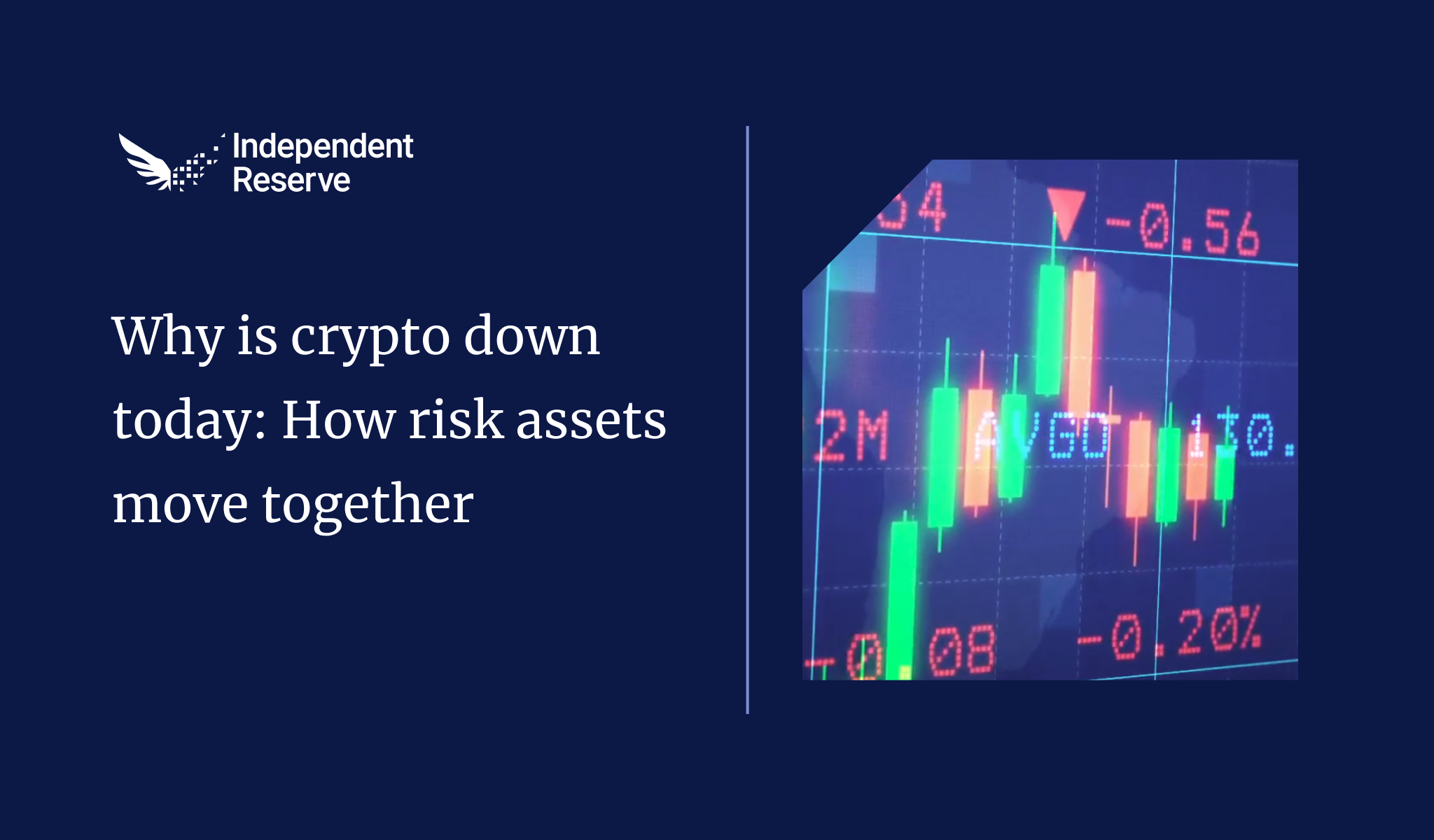In Markets
Crypto markets are still bearish after the Federal Reserve hiked interest rates by another 75 basis points. Rates are now headed towards 4.6% and the Fed is sounding very hawkish on bringing inflation down. A turnaround doesn’t seem likely in the short term with Glassnode’s latest report noting that rising volumes amid a bearish trend are a bad sign: “Whenever spot volume backs a downward trend, it tends to extend into the near future, and a reversion requires substantial buying pressure.” The good news however is that adoption continues to grow and the current Crypto Winter can’t last forever. At the time of writing Bitcoin was down 2% for the week to trade around A$30,500 (US$19.7K) and Ethereum had lost 3% to trade at A$2,115 (US$1,360). Despite the price dips, around 51% of ETH holders are currently still in profit. XRP shot up (22%) on speculation about a resolution of its court case, Cardano lost 2% and Dogecoin gained 3% after Ethereum cofounder and Doge fan Vitalik Buterin suggested it could move to proof of stake. The Crypto Fear and Greed Index is at 20 or Extreme Fear.

From the IR OTC Desk
Last week’s US Federal Open Market Committee (FOMC) decision saw the federal funds rate increased by 75bps to 3.00-3.25%. In a telling sign that the FOMC were unwavering in their inflation mandate, the dot plot survey (an anonymous survey of expectations for each individual FOMC member) highlighted a median expectation of an additional 1.25% increase in the federal funds rate by the end of the year.
In the press conference, Federal Reserve Chair Jerome Powell emphasised the tightness of the labour market. And in response to the dual mandate of the FOMC (maximum employment and price stability) it was clearly articulated that price stability is the current focus. This Friday, the 30th September at 1030pm AEST we receive the PCE inflation data for the month of August. This is the Federal Reserve’s preferred measure for inflation. Current expectation is for the Core PCE Price Index YoY (Aug) to increase by 0.1% to 4.7%. The value of core PCE will prove incredibly important for risk asset pricing.
Last week we highlighted that the risk to the Reserve Bank of Australia was another ‘jumbo’ rate increase by the US FOMC. The reasoning behind this relates to the effect of widening interest rate differentials, causing the AUD/USD to depreciate. This is despite the strongest labour market in Australia in nearly 50 years, as well as a record high terms of trade.
With the pace of interest rate increases forecast to accelerate in the US, AUD/USD has now moved below US 65c. Even though the RBA has most recently articulated that increases to the cash rate can be felt with ‘long and variable lags’, interest rate futures continue to point to a 90% chance of a 50bp increase at next Tuesday’s interest rate meeting. If delivered, this would take the underlying cash rate in Australia to 2.85%. At the time of writing, the expected terminal rate (as forecast by the interbank bill future) is circa 4.20% for Q1 2023.
In markets, the USD currency basket (as expressed by the DXY) has ended the week materially higher at 113.70. US 2yr Treasury Note yields have moved higher, from 3.95% to circa 4.30%. The NASDAQ 100 is off circa 6.2% at 11,254.11. In the short term, cryptocurrencies have broken down their correlation to US interest rates and US equities, materially outperforming this week.
On the OTC desk, volumes have been highly correlated to the rise and fall of the DXY. As the DXY falls intra trading session, prices of BTC and ETH have tended to rise, seeing more client interest across the portfolio (and vice versa). ETH proof of stake (PoS) yields continues to move higher, up from 4.25% last week to circa 4.7% this week. Under a backdrop of rising US interest rates, the relative staking yield of ETH remains an incredibly important benchmark to the cost of carry for the asset. Investors will continue to weigh up growth opportunities of the protocol versus funding costs.
For any trading needs, please don’t hesitate to get in touch.
In Headlines
XRP shoots up
The Ripple community appears to be super hopeful about a successful resolution to the illegal securities case brought by the SEC (or some insiders somewhere know something) because the price jumped 40% in two days last week and XRP finishes the week up by one third. The case is coming to an end one way or another with both parties filing for summary judgements.

XRP/AUD chart on Independent Reserve
Vasil upgrade goes live
Cardano’s Vasil upgrade hard fork has finally gone live after three months of delays. The technical changes improve the ledger’s programmability and its throughput potential and enable faster block creation. Upgrades to make its Plutus smart contracts more efficient will allow DApps to run with lower costs. Cardano founder Charles Hoskinson took aim at the media for focusing on the months of delays given Ethereum’s Merge had been delayed by years, and he suggested that hundreds of projects were prepping to launch following the upgrade.
Bad good guys take aim at DAO members
Until now the US Commodities Futures Trading Commission was seen as the “good” regulator by the crypto community, in opposition to mean old Securities and Exchange Commission. That all changed this week when the CFTC filed a federal civil enforcement action against the members of a decentralised autonomous organisation called Ooki DAO over crypto trading violations. Going after the members of a DAO is unprecedented and interestingly even CFTC commissioner Summer Mersinge wrote a dissenting opinion saying it was a bridge too far: “This approach constitutes blatant ‘regulation by enforcement’ by setting policy based on new definitions and standards never before articulated by the Commission or its staff, nor put out for public comment,” she said. The circumstances of the case are unique however given that Ooki DAO was formed to look after the bZerox protocol after the exact same charges were pressed and settled against the platform’s founders for “illegally offering leveraged and margined retail commodity transactions in digital assets.”

SEC still bad though
The SEC this week made the novel argument that because 42.56% of Ethereum nodes are based in the US, that means that all Ethereum transactions take place in the US. The dubious argument is found in the SEC’s lawsuit against crypto researcher and personality Ian Balina for conducting an unregistered offering with the Sparkster token. Aussie lawyer Aaron Lane, from the RMIT Blockcahain Innovation Hub said the fact the case involved a US plaintiff and defendant was more relevant to the jurisdiction than the nodes argument and it was unlikely to set a precedent.
Two year ban on algo stablecoins mooted
Stablecoin legislation being drafted in the US House of Representatives would place a two year ban on any new Terra style algorithmic stablecoins. Existing stablecoins that are “endogenously collateralised” – (collateralised with another token from the same issuer) have two years to come up with a new model. This could affect projects like Synthetix, although that protocol has already been tinkering with other forms of collateral for sUSD than just the SNX token. Any stablecoin legislation is unlikely to be finalised until the first quarter of 2023 according to U.S. Congressman Warren Davidson.

JPMorgan boss hates crypto again
JPMorgan Chase CEO Jamie Dimon testified to the US Congress this week that while he sees some value in DeFi, smart contracts and “tokens that do something” he also thinks Bitcoin and cryptocurrencies overall are “dangerous” and that “they are decentralised Ponzi schemes, and the notion that’s good for anybody is unbelievable.”
Apple to take a 30% cut of NFTs
Apple’s app store will happily let marketplaces sell NFTs – but it wants a 30% commission to be paid in USD for each sale. The policy caused NFT startup Magic Eden to withdraw from the app store and would make an OpenSea NFT marketplace app unlikely. However, the policy might be beneficial to gaming related NFTs or low costs NFTs by helping expose them to a huge audience.

Bitcoin was almost Netcoin
A fun fact emerged this week: it appears as if Satoshi Nakamoto has toyed with calling his new cryptocurrency ‘Netcoin’ instead of Bitcoin. The conclusion is based on registrations made at the AnonymousSpeech domain name service where Bitcoin.org was registered on August 18, 2008. A day earlier the domain ‘Netcoin.org’ was purchased, suggesting Satoshi bought it and then decided to go with the better name. Good call.
Until next week, happy trading!


